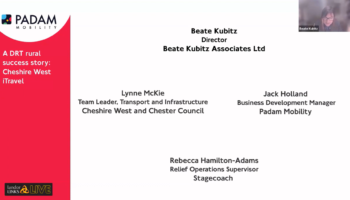Because dynamic demand-responsive transit is to DRT what the smartphone is to the landline phone: a solution that makes its ancestor outdated, thanks the combination of technology and intelligence, in line with the changing uses.
A cheaper and more accessible shared mobility solution
Historically linked to senior public and mobility impaired people, demand-responsive transit is now opened to all audiences. Leisure, studies, shopping, employment… Suitable to all territories and scales, dynamic demand-responsive transit offers new opportunities for communities:
- Flexible and intelligent, dynamic DRT ensures a significant decrease in operating costs and carbon footprint.
- More accessible, it guarantees social inclusiveness by addressing the issues of precariousness-mobility, mainly in peri-urban and rural areas, while being compatible with the transport of mobility impaired people.
- In sync with mobility innovations, it saves time for people.
Despite its many advantages, DRT suffers from the image of the aged demand-responsive transit solutions deployed decades ago: heavy in terms of investment, long to deploy and complex to operate.
Technological advances, particularly the optimization of journeys in real time thanks to artificial intelligence, make it an extremely easy mobility solution to implement.
Demand-responsive transit: a simple and fast solution to deploy
Nowadays, thanks to technological innovations, new turnkey solutions are being developed to answer more effectively the needs of territories and users.
Unlike other systems, SaaS demand-responsive transit solutions simplify service implementation and ease day-to-day network management:
- No installation is required on the computers. The acquisition cost is significantly reduced, as well as the cost of maintenance and updates.
- These solutions offer great freedom of use, since they can be accessed from any connected device.
- The tools are hosted on secured servers: maintenance and service guarantee are greatly improved
- The needs of the territory covered define the functionalities to which users have access.
In addition, SaaS demand-responsive transit solutions do not involve any disruption for end users. Indeed, these tools can coexist with older systems, such as reservation centrals that access reservation interfaces. Users may also prefer a mobile application to book their trips. As for drivers, they can follow in real time the evolution of their journey via the application.
To determine the outlines of the best offer to deploy, some solutions provide simulation tools to study a given territory beforehand: number of vehicles, number of stops, service models, etc…
Depending on the customization required, the deployment of a SaaS demand-responsive transit tool last from 1 to 3 months. The data collected during operation help to improve the service permanently and to study new approaches to evolve the demand-responsive transit network.
Ready to give up your wire? Find out about Padam Mobility’s on-demand transport solutions here.





